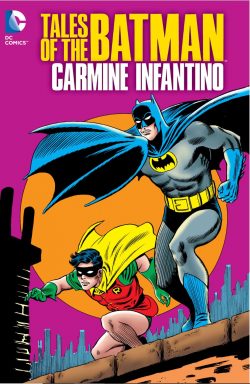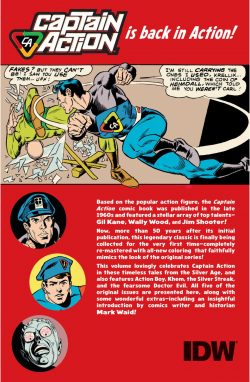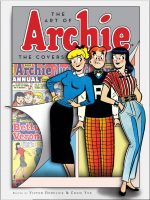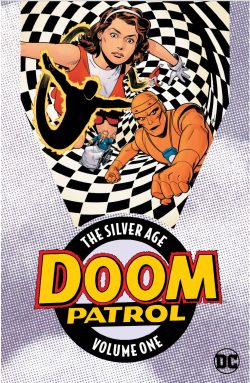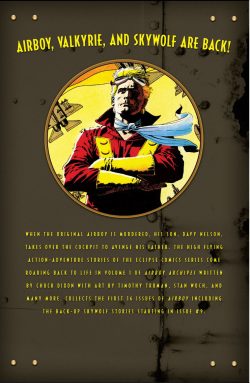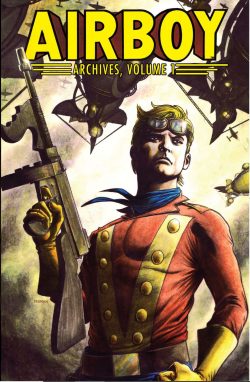
By Nicola Cuti & Joe Staton & various (First Comics Inc.)
ISBN: 978-1-61855-000-2 (TPB/Digital edition)
In 1973, superheroes were in a severe decline and the few surviving publishers in the industry were making most of their money from genre fare like war, westerns, kids cartoon and licensed titles (if they could secure them) and particularly horror stories. Such was certainly the case at Charlton Comics: a self-confessed “little company” which nevertheless always punched above its weight.
That was particularly true in terms of talent discovery, with the likes of Dick Giordano, Sam Glanzman, Steve Ditko, Roy Thomas, Denny O’Neil, Jim Aparo, Sam Grainger, Sanho Kim, Wayne Howard, Tom Sutton, Don Newton, Mike Zeck, Roger Stern, Roger Slifer, Bob Layton and John Byrne making a mark there before moving onwards and upwards.
Another major discovery was ultra-versatile cartoonist Joe Staton. He was quickly becoming a fan favourite and shared an off-kilter sense of humour with a Charlton sub-editor who moonlighted as a writer of horror and fantasy for the company’s anthologies…
Nicola “Nick” Cuti (Moonchild, Cannon, Sally Forth, Creepy, Moonie the Starbabe, The Creeper, Spanner’s Galaxy, Captain Cosmos, Starflake the Cosmic Sprite) was born on October 29th 1944. Since then, he’s been an “Underground Comix” cartoonist, animator, film maker, magazine illustrator, movie backdrop designer, novelist, editor and comics scripter.
Between 1972 and 1976 he was assistant to award-winning cartoonist – and Charlton’s general editor – George Wildman (Popeye) who wanted to test the murky waters with a new superhero. He tapped Cuti to write something a bit different and used the experimental vehicle to try-out a succession of features at the back: crafted by creators like Sutton (The Knight), Ditko (Killjoy, Liberty Belle) and Byrne (Rog-2000). Cuti wrote many of them too…
Born January 19th 1948, Joe Staton (Primus, Wheelie and the Chopper Bunch, The Six Million Dollar Man, Space 1999, The Avengers, The Incredible Hulk, Deadly Hands of Kung Fu, Silver Surfer, Green Lantern Corps, Guy Gardner, Legion of Super-Heroes, Millennium, All Star Comics, Power Girl, Metal Men, Doom Patrol, Plastic Man, Mike Danger and more) is a writer and incredibly versatile artist/inker who has been an integral part of American comic books since the early 1970s.
He has worked for dozens of companies, co-creating The Huntress, Killowog, The New Guardians and The Omega Men and in later years made kids comics his metier. During a spectacular run on licensed classic Scooby Doo, he and series scripter Mike Curtis (Casper the Friendly Ghost, Richie Rich, Shanda the Panda) discovered a mutual love for Dick Tracy and – mostly for their own amusement – created tribute strip Major Crime Squad.
That led to them being invited to handle the prestigious Dick Tracy strip (from 2011 to October 2021) but throughout that epic and varied career, Staton regularly re-partnered with Cuti on further adventures of his first triumph…
A pioneering masterpiece of superhero whimsy, E-Man tells the convoluted love story of a alien lifeform and a wonderfully capable and smart earth girl, and the weird life they make for themselves. It all began in 1973 (Happy Golden Anniversary!) in a 10-issue run that was barely noticed by the readership but which affected how many future comics creators remade the medium.
This cheerful and charming collection gathers the E-Man moments from that initial run and includes technically unpublished tales from said run, plus covers and other material from the hero’s revival as part of the Independents Publishing revolution of the 1980s.
We begin with a brace of Introductions as ‘Finding the Right Words for Joe, Nick and Alec Tronn’ by Jon B. Cooke and ‘E-Man: His Beginnings’ by Cuti contextually set the scene for an extraordinary meeting…
Cover-dated October 1973, “Collector’s Item! First Edition!!” E-Man #1 starts at ‘The Beginning’ revealing how, millions of years ago, a star exploded and released a packet of energy that had spontaneous sentience, immense curiosity and no knowledge at all. The bundle of wonder floated across the galaxies seeking intelligence but encountering none until arriving near our world just as a star-ship from Sirius attempts to attain orbit around Pluto.
Infiltrating the vessel, the energy being converts into matter, duplicating one of the robots serving the giant Brain commanding the mission and overhears how the warlike cyborg is here to test an experimental ultra-weapon on the frozen target. Sadly, curiosity proves fatal and the sudden weight increase sends the ship careening out of control and ultimately into the atmosphere of the blue-green planet third out from the sun…
Some time later, college student Katrinka Colchnzski is just finishing her evening job. She is a tough, brilliant, capable and proudly independent: paying for her degree as burlesque dancer Nova Kane when one of the lightbulbs in her dressing room begs her for help.
Freeing the energy creature and quickly striking up a friendship with the naïve, affably clueless being – who has unselfconsciously turned into a real stud-muffin by human standards – she is abruptly drawn into a world of insane danger when her landlord tries to kill her. It transpires that in ‘The Brain and the Bomb’ the super cerebral invader has also survived the crash and is vengefully testing hate-gas on the inhabitants…
Without hesitation Nova and the stranger seek out and stop the plot…
These tales were originally quite quirkily coloured by Wendy Fiore and are reconstructed here by Matt Webb, who also shades the cover to Original E-Man #1: a reprint series released by First Comics in October 1985 to supplement their revival of the hero. That book also revisited the second escapade of guileless alien visitor Alec Tronn as first seen in E-Man #2’s ‘The Entropy Twins’ (December 1973). Here, the Brain from Sirius unleashes a second super-weapon against E-Man and Nova: an artificially-bred loving couple who can casually manipulate the forces of order and chaos.
Stalking and befriending the childlike hero and his charming cohabitator, Michael and Juno cause catastrophic accidents which almost kill Nova, only to learn that her special friend Alec is as vengeful as any child when the things he loves are threatened…
An unused cover from 1974 accompanies article ‘The Energy and Paper Crisis’, explaining how a global power shortage both inspired and derailed a comic response. The upshot was that the story intended for the fourth issue ended up in #3, and the third followed after. The chronological anomaly is corrected here with E-Man #4 going first.
Cover-dated August 1974, ‘City in the Sand’ sees the odd couple in Egypt with exotic dancer Nova showing belly dancers how it’s done at night and pursuing her archaeological studies during the day. With Alec in tow, she unearths an ancient mystery and – thanks to E-Man – functional time machine: propelling them back millennia to uncover a link between the pharaohs and a lost colony of aliens afflicted with mad militarism and a sinister plague…
December 1985’s cover of Original E-Man and Michael Mauser #3 precedes June 1974’s E-Man #3, wherein ‘The Energy Crisis!’ blacking out America and the world leads oil baron Samuel Boar to unleash a robotic Battery to kidnap useless, over-abundant humans and turn them into a new fuel source.
When Nova vanishes, E-Man stops powering up hospitals to go looking for her. He is unaware that Nova had already engaged seedy private eye Michael – “don’t call me Mickey” – Mauser to find her fellow dancer Rosie Rhedd after she was sucked into a brick wall…
The sordid shamus became a fixture and even won his own series in Vengeance Squad….
The invasion of Boar’s citadel and clash with ‘The Battery’ is fast and furious and leads to the villain’s capture but would have shocking consequences in the fullness of time…
The tale ends with a direct plea to readers to protect the environment and “save the Earth!”. It’s a shame more kids didn’t buy this comic back then and avoid the mess we’re all in now…
Staton had been growing in skill and confidence and by this story had taken to adding what we now call easter eggs to his art. Backgrounds, minor characters and especially posters and newspapers provided a rich source of added whimsy, commentary and fun. They are a sheer delight to this day…
The Original E-Man #2 cover from October 1985 leads into November 1974’s #5 as ‘The City Swallower’ sees a day at the beach devolve into a transdimensional excursion. When Alec follows a hippy mermaid (based on contemporary and legendary fandom icon Heidi Saha) back to her realm he’s just in time to spearhead a war against a beast that consumed helpless conurbations, after which January 1986’s Original E-Man and Michael Mauser #4 cover leads to monster madness in E-Man #6.
‘Wunder-world’ – cover-dated January 1975 – sees an old enemy resurface when Alec and Nova visit a theme park, using robots, movie horrors, war machines and psychological warfare to attack the unlikely couple…
A full, illustrated list of ‘E-Man and Nova – Other Appearances’ is followed by #7’s ‘TV Man’ (March 1975) as another old enemy uses the airwaves and super-science to turn the energy- man into Nova’s worst nightmares and Mauser reappears to save the day. It’s followed by Original E-Man and Michael Mauser #5’s cover (February 1986) and heralds a really big change…
With #8’s full-length epic ‘The Inner Sun’ (May 1975) the creators brilliantly exploit the capricious, functionally implausible nature of comics books to deliver a superb slice of nonsense that begins when a giant jungle girl attacks New York. When she then busts into Mauser’s office…
Her trail leads to Samuel Boar and a primeval world under the North Pole…
Unless I’ve already convinced you to seek this book out, be warned that there’s a major spoiler ahead. Stop here if you’re going to read the actual stories. Or not. It’s your choice.
By the time E-Man gets there though, the villain has kidnapped Nova and triggered a disaster that kills her. It’s not anything to worry about as – through typically miraculous circumstances – she reconstitutes herself with the same powers as boyfriend Alec and begins her own crime crushing career…
March 1986’s cover to Original E-Man and Michael Mauser #6 is accompanied by text feature ‘Other Appearances by Michael Mauser’ before E-Man #9 (July 1975) unleashes ‘The Genius Plant’ which is foreshadow by brief ‘Prologue! History of E-Man and Nova’…
Accompanied by new cast member Teddy – a reformed evil koala – the hot couple stumble into a plot by a cabal of scientists to hyper-enhance their intellects and rule the world. After they foil that, one final cover – Original E-Man and Michael Mauser #7 (April 1986) – segues into E-Man #10 (September 1975) as Nova meets the first girl Alec met when he landed on Earth. Although initially jealous, after meeting Maisy-June Bragg, she’s with her beau all the way when what appear to be unnatural forces reduce the gentle rural bombshell into ‘The Witch of Hog Hollow’ who really needs her old “genie” to save her…
E-Man was simultaneously Charlton’s worst selling retail title but its best via direct subscription, which kept it going long after Wildman should have killed it, but at last the axe fell. When it died, there were a couple of tales still in the pipeline which eventually saw print in the company’s in-house fanzine – which was edited by Bob Layton.
Coloured by Webb, Staton’s cover for Charlton Bullseye #2 (1975) and Charlton Bullseye #4 (March/April 1976) here precede ‘…And Why the Sea is Boiling Hot’ (colour by Webb & Michael Watkins) wherein the energy-beings investigate missing shipping and discover that a ghost galleon is actually an alien artefact.
One final story – starring Nova Kane – details a stunning truth. When that exploding sun detonated way back when, it spawned more than one sentient energy-being – and courtesy of FIRST COMICS INC. – Alec’s opposite number ‘Vamfire’ finally arrives on Earth in a scary yarn coloured by Alex Wald. This frenzied female aspect is a ravenous power leech but Nova and E-Man soon find a way to dispel her “hanger-pangs”…
Biographies of Nicola Cuti and Joe Staton close this archive of sheer escapist delight: capping a glorious revisitation of sharper, smarter, funnier days in comics. However it’s not too late to tune in and get turned on to E-Man and Nova.
© 1973-1974 Charlton Comics, reprinted in Original E-Man and Mauser #1-7 © 1985-1986, First Comics, Inc. All new material © 2011, Joe Staton/First Comics, Inc.). All Rights Reserved.


